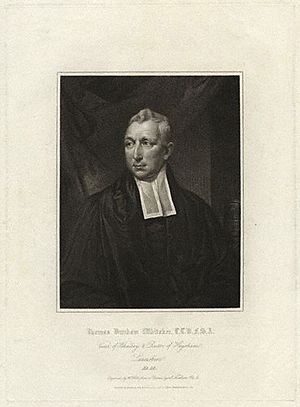Thomas Dunham Whitaker facts for kids
Thomas Dunham Whitaker (born 1759, died 1821) was an English clergyman and a historian who studied places. He was known for writing detailed books about the history and geography of different areas in England.
Contents
Early Life and Education (1759-1782)
Thomas Dunham Whitaker was born in Raynham, Norfolk, on June 8, 1759. His father, William Whitaker, was a church leader there. In 1760, when Thomas was very young, his family moved to Holme, Lancashire.
When he was seven, Thomas went to live with the Rev. John Shaw in Rochdale for his schooling. Later, he studied with the Rev. William Sheepshanks. In 1774, he was accepted into St John's College, Cambridge University. He earned a law degree (LL.B.) in 1781. Thomas had planned to become a lawyer. However, his father passed away in 1782. This led Thomas to change his plans and settle at his family home in Holme.
Becoming a Church Leader (1785-1821)
Thomas Dunham Whitaker became a priest in 1785. For a while, he didn't have a specific church to lead. In 1788, he paid to rebuild Holme Chapel. In 1797, he became the leader of this church. He earned a higher law degree (LL.D.) in 1801.
In 1809, he became the vicar of Whalley, a large church area in Lancashire. He also took on the role of rector at Heysham in 1813, but he left that position in 1819. In 1818, he became the vicar of Blackburn. He continued to lead both the Whalley and Blackburn churches until he died.
Community Work and Interests
Thomas Dunham Whitaker was very involved in his community. When he lived at Holme, he started a local book club. He was respected by the people in his churches. He used his influence to help calm down problems, especially during a disturbance in Blackburn in 1817. For his helpful actions, he received a special award in April 1821.
He was also very interested in the history of places and in growing trees. He wrote many books on these subjects. In 1818, he was chosen to be a member of the Royal Society. This is a famous group for people who are good at science and knowledge.
Thomas Dunham Whitaker passed away on December 18, 1821, at his home in Blackburn. He was buried in Holme. He had married Lucy Thoresby in 1783, and they had several children. One of his sons, Robert Nowell Whitaker, also became the vicar of Whalley later on. A monument was built in his honor at Whalley church in 1842.
Published Works and Writings
Thomas Dunham Whitaker was a very busy writer. He published many important books about the history of different parts of England. Here are some of his most well-known works:
- History of the Original Parish of Whalley and Honour of Clitheroe (1801): This book was about the history of Whalley and a nearby area called Clitheroe. It was so popular that it was printed four times!
- History and Antiquities of the Deanery of Craven (1805): This book focused on the history of the Craven area.
- De Motu per Britanniam Civico annis 1745 et 1746 (1809): This was a book written in Latin about a rebellion that happened in Britain in 1745-1746.
- Life and Original Correspondence of Sir George Radcliffe (1810): This book was about the life of Sir George Radcliffe, a friend of a famous historical figure named the Earl of Strafford.
- The Sermons of Dr. Edwin Sandys (1812): He edited and wrote about the sermons of a former Archbishop of York.
- Visio Will'i de Petro Plouhman (1813) and Pierce the Ploughman's Crede (1814): These were editions of old English poems.
- Loidis and Elmete (1816): This book explored the history of the Airedale and Wharfdale areas.
- The History of Richmondshire (1823): This two-volume work was published after his death. It included beautiful pictures by the famous artist J. M. W. Turner.
Whitaker also helped to update another important history book called Ducatus Leodiensis in 1816. He had plans for other books, but he didn't get to finish them. He also published ten speeches he had given and wrote many articles for a magazine called the Quarterly Review.


